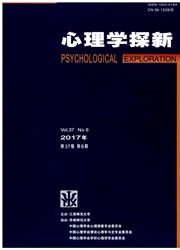

 中文摘要:
中文摘要:
他人的视线或者箭头等线索能够自动地转移观察者注意到线索所指向的位置或物体上。很多研究试图比较视线线索和箭头线索在转移注意时的不同,但最终的结论仍然存在争议。当前研究采用混合呈现不同线索类型的方式进行实验,发现视线线索引起了比箭头线索更强的线索效应。并且这一现象只在相对较长的SOA情况下出现。这一发现说明视线线索和箭头线索在注意转移系统的自上而下高层认知处理阶段被区别对待,视线线索是比箭头线索更有效的线索。
 英文摘要:
英文摘要:
A centrally- presented, uninformative gaze cue can induce automatic shifts of attention. This phenomenon has led some researchers to suggest that eye gaze is a special attentional cue, probably because of its biological significance. However, against the special notion for gaze cueing,more and more behavior studies observed significant cueing effects when arrows, instead of gazes are used as cues. These findings raise the possibility that gaze cueing is not a unique or special process, so plenty of researches have tried to find the difference between gaze cueing and arrow cueing. However, though many behavioral studies have tried to prove the specialty of gaze cues from other symbolic cues like arrows, indistinguishable results are generally observed and no robust differences are found. Different from previous studies that used between -block design, the present study compared the attention orienting between gaze and arrow cues in a within - block design. A within - block design is expected to eliminate the potential influences that occur across the two cue conditions when cue type is blocked and allow top - down processes, such as direct comparison between cue types, to occur. In experiment 1, previous undistinguishable results were replicated under a between - block design. In experiment 2, the central cues were chosen randomly within one block. The results showed that gaze - induced cueing effects are stronger than arrow - induced cueing effects, at least at relatively long SOAs. The present findings suggest that the attentional mechanisms induced by gaze and arrow cues differ in higher cognitive processes, and eye -gaze triggers attention orienting more effectively than arrow cues. In all, by adopting a within -block mixing design in the traditional cueing paradigm, the present study finds a way to compare the attention shifting abilities of gaze cues with that of arrow cues, and helps to resolve the discrepancy in the previous literatures dealing with the special notion of gaze cues on attention systems.
 同期刊论文项目
同期刊论文项目
 同项目期刊论文
同项目期刊论文
 期刊信息
期刊信息
